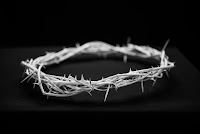Fruitless Temple
The Gospel of Mark divides the story of the barren fig tree into two sections and places the “cleansing” of the Temple between them. The two incidents are closely linked. The fruitlessness of the fig tree and its cursing highlighted the failure and fate of the Temple, and the actions of Jesus foreshadowed its destruction. After his arrival in the city of Jerusalem, he first visited the Temple and “looked around on all things.”
It was appropriate for the Messiah to visit the Temple, and it was in fulfillment of Malachi’s prophecy - “The Lord whom ye seek will come suddenly to his temple… And I will come near to you to judgment.” He was the one who would sit as the “Refiner and Purifier of the sons of Levi” - (Malachi 3:1-4).
 |
| [Photo by Johann Siemens on Unsplash] |
His initial visit anticipated his confrontations with the religious leaders of Israel, and these for the most part occurred in and around the Temple. The opposition from the priestly authorities would lead Jesus to leave the Temple for the last time when he pronounced its coming destruction.
In the Gospel of Mark, the story of the barren fig tree follows the first visit of Jesus to the Temple after his arrival in the city of Jerusalem.
- (Mark 11:12-14) - “And on the morrow, having departed from Bethany, he hungered, and seeing a fig tree from afar spouting leaves, he came if perhaps he might find anything on it, and having come to it, he found nothing except leaves. for it was not the season of figs. And having answered, he said to it, ‘No longer from you will anyone eat fruit unto the age to come.’ And his disciples were listening” - (Parallel passage - Matthew 21:18-19).
THE TEMPLE WITHOUT FRUIT
The event occurred in the spring when figs are NOT in season. The fruit ripens in late summer. But in the spring, fig trees sprout leaves and edible green knops known as paggim (Hebrew). When Jesus saw the foliage, he most likely expected to find paggim to eat.
The appearance of the green knops would indicate that a fig tree will produce fully formed fruit in the summer, but the lack of them in the spring would mean it will not do so. In this case, the tree’s green leaves gave the impression that it was a fruit-bearing tree, at least, from a distance.
Several Old Testament prophets used the image of a fig tree to symbolize JUDGMENT ON THE NATION OF ISRAEL. Likewise, in Mark, the cursing of the fig tree symbolizes the impending judgment of the Temple.
Outwardly, the Temple appeared fruitful, just like the fig tree that sprouts green leaves. But behind the façade, Israel had failed to produce the required fruit of repentance and holiness - (Isaiah 34:4, Jeremiah 8:13, 29:17, Hosea 2:12, 9:10, Joel 1:7, Micah 7:1).
In the Temple, the “moneychangers” operated in the Court of the Gentiles, the only area where uncircumcised Gentiles were allowed. At this time, the opening of the Court to the “moneychangers” was a recent innovation - (Mark 11:15-19, Matthew 21:12-17, Luke 19:45-46, John 2:13-17).
The exchange of money and the animal trade associated with the sacrificial system provided the Temple with significant revenues. The function of the “moneychanger” was to exchange foreign currency for shekels since the Law required the Temple tax to be paid in that currency - (Exodus 30:13-16).
The actions of Jesus were not to protest commercial activity, but instead, to object to the barriers to Gentile participation in the Temple rituals erected by the religious authorities. He expelled both those buying and those selling animals for sacrifice. Moreover, the observation that he prevented people from carrying “vessels” through the Court points to something more than an objection to profiteering.
Since the Court of the Gentiles was the only part of the Temple where non-Jews could worship God, their participation would be hindered by the “moneychangers.” And commerce in animals would involve an enormous number of beasts during major pilgrimage feasts.
That Jesus acted in the Court of the Gentiles and alluded to a clause found in Isaiah while doing so demonstrates that the issue of Gentile participation was at the heart of his action. The Temple authorities may have profited from this trade, but they did so at the expense of Gentile participation in prayer and worship - (“My house will be called a house of prayer for all nations” - Isaiah 56:8).
His act symbolized the rejection of the Temple cult by Yahweh for its failure to produce the required fruit, especially the inclusion of the Gentiles in His worship. Implicitly, Jesus called the Temple leaders “brigands.” The Greek term léstés means “brigand” and not just a common thief. At the time, it denoted something more akin to violent revolutionaries. Thus, he made a judicial pronouncement against the Temple and its leadership.
Jesus quoted two Old Testament passages. Note the references to “my mountain” in Isaiah, and to Judah being “cast out” in Jeremiah:
- (Isaiah 56:3-8) - “…And as for the sons of the foreigner who have joined themselves unto Yahweh to wait upon him and to love the name of Yahweh, to become his for servants, everyone who keeps the Sabbath lest he profane it, and who lays firm hold on my covenant, surely I will bring them into MY HOLY MOUNTAIN, and make them joyful in my house of prayer, their ascending–offerings and their sacrifices being accepted upon mine altar, for MY HOUSE A HOUSE OF PRAYER SHALL BE CALLED FOR ALL THE PEOPLES!’ Declares my Lord, Yahweh, who is gathering the outcasts of Israel: Yet others will I gather unto him besides his own gathered ones.”
- (Jeremiah 7:8-15) - “…A DEN OF ROBBERS has this house on which my Name has been called become in your own eyes? I also, lo, I have seen it, declares Yahweh… Therefore, will I do to the house whereon my Name has been called, wherein you are trusting, even to the place which I gave to you and to your fathers, just as I did to Shiloh; and WILL CAST YOU OUT from before me, just as I HAVE CAST OUT all your brethren, all the seed of Ephraim.”
The first passage refers to eunuchs and Gentiles. Under the old covenant, they could not participate fully in Temple rituals. But the time would come when Yahweh would make them full participants in the covenant community. It was always His intent to make His Temple a place of worship for all people regardless of ethnicity or ceremonial uncleanness - (castration made one ceremonially unfit).
Originally, the prophecy was fulfilled by the Babylonians when Nebuchadnezzar destroyed the Temple and removed its vessels. Here, the Temple authorities are angered and begin to plot his destruction. What Jesus portrayed was not the future restoration of the Temple, but its demise.
WITHERED FIG TREE
By prefacing his next remarks with “Amen, I am declaring to you,” Jesus gives them ultimate authority. The description of the fig tree as “withered from its roots” demonstrates its imminent and complete destruction. Never again would it produce fruit or foliage. It also echoed the earlier Parable of the Sower in which some “seed” fell on the “stony ground” and “withered” because it had “no root” - (Mark 4:5-6, 11:20-26).
The cursing of the fig tree was about the impending destruction of the Jerusalem Temple. Despite its flourishing foliage, the “fig tree” remained fruitless.
In his pronouncement, Jesus did not refer to just any mountain, but to “THIS mountain.” The Greek demonstrative pronoun is emphatic. This was not simply a generic statement concerning how faith brings answers to prayer, but one that concerned a specific mountain - the Temple Mount.
Jesus is the one who declares to “this” mountain, “Be removed and cast into the sea!” He was describing the coming destruction of the Temple, a judgment symbolized by his actions in the Court of the Gentiles and his cursing of the barren fig tree.


Comments
Post a Comment